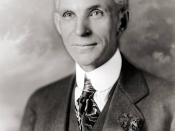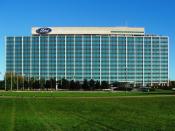1.0 Introduction
The Ford Motor Company finds itself in a dynamic business environment where new technologies and practices offer the potential to alter in a significant way the landscape in which it operates. Henry Ford was in his time an innovator in offering "cars for the masses". He introduced to the car industry methods and systems innovative in their day. Ford needs once again to forge new paths to ensure future competitive advantage.
Executives at Ford have been considering the "Direct Model" created by Dell Computer Corporation and finds that there is considerable appeal. Dell has been able to speed up inventory velocity such that there is only eleven days of inventory on hand. This has led to an inventory turnover rate of thirty times per annum. This achievement, termed by Michael Dell "Virtual Integration" has been achieved by blurring the line between supplier, Dell and client, to the extent that third party service staff are often thought, by clients, to be Dell's own staff.
2.0 The Company and Industry Background
Ford Motor Company entered the business world on June 16, 1903, when Henry Ford and 11 business associates signed the company's articles of incorporation. With $28,000 in cash, the pioneering industrialists gave birth to what was to become one of the world's largest corporations. Few companies are as closely identified with the history and development of industry and society throughout the 20th century as Ford Motor Company.
Ford's new global approach required that technology be employed to overcome the constraints usually imposed by geography on information flow. IT was placed within the process reengineering organization. In the supply chain area, there was general agreement that IT also could be deployed to dramatically enhance material flows and reduce inventories, substituting information for inventory. Ford continued to expand in the...


